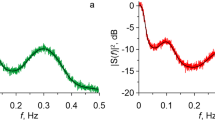Abstract
In the present paper, the theoretical basis of autoregressive (AR) modelling in spectral analysis is explained in simple terms. Spectral analysis gives information about the frequency content and sources of variation in a time series. The AR method is an alternative to discrete Fourier transform, and the method of choice for high-resolution spectral estimation of a short time series. In biomedical engineering, AR modelling is used especially in the spectral analysis of heart rate variability and electroencephalogram tracings. In AR modelling, each value of a time series is regressed on its past values. The number of past values used is called the model order. An AR model or process may be used in either process synthesis or process analysis, each of which can be regarded as a filter. The AR analysis filter divides the time series into two additive components, the predictable time series and the prediction error sequence. When the prediction error sequence has been separated from the modelled time series, the AR model can be inverted, and the prediction error sequence can be regarded as an input and the measured time series as an output to the AR synthesis filter. When a time series passes through a filter, its amplitudes of frequencies are rescaled. The properties of the AR synthesis filter are used to determine the amplitude and frequency of the different components of a time series. Heart rate variability data are here used to illustrate the method of AR spectral analysis. Some basic definitions of discrete-time signals, necessary for understanding of the content of the paper, are also presented.
Similar content being viewed by others
References
Transnational College of LEX. Who is Fourier? A mathematical adventure. Belmont, MA, USA: Language Research Foundation, 2000.
Lyons RG. Understanding digital signal processing. Chapter 3. Upper Saddle River, NJ: Prentice-Hall, 2001.
Akselrod S, Gordon D, Übel FA, Shannon DC, Barger AC, Cohen RJ. Power spectrum analysis of heart rate fluctuation: A quantitative probe of beat-to-beat cardiovascular control. Science 1981; 213: 220–222.
Golten J. Understanding signals and systems, pp. 188–193. Berkshire, England: McGraw-Hill Publishing Company, 1997.
Orfanidis SJ. Optimum signal processing. An introduction, pp. 184–192. New York, NY: Macmillan Publishing Company, 1985.
Yule GU. On a method of investigating periodicities in disturbed series. With special reference to Wölfer's sunspot numbers. Philos T of Royal Soc A 1927; A226: 267.
Walker G. On periodicity in series of related terms. P Roy Soc Lond A Mat 1931; A131: 518.
Levinson N. The Wiener RMS (root-means-square) error criterion in filter design and prediction. J Math Phys 1947; 25: 261–278.
Durbin J. The fitting of time series models. Rev Int Statist I 1960; 28: 233–244.
Akaike H. A new look at the statistical model identification. IEEE Trans Autom Contr 1974; 19(6): 716–723.
Akaike H. Statistical predictor identification. Ann Inst Statist Math 1970; 22: 203–217.
Parzen E. An approach to time series modelling and forecasting illustrated by hourly electricity demands. Technical Report 37, Statistical Science Division, State University of New York, January 1976.
Rissanen J. Modeling by shortest data description. Automatica 1978; 14: 465–471.
Meddins B. Introduction to digital signal processing. Page 102. Oxford, Auckland, Boston, Johannesburg, Melbourne and New Delhi: Newnes, 2000.
Lyons RG. Understanding digital signal processing. Chapter 5. Upper Saddle River, NJ: Prentice-Hall, 2001.
Meddins B. Introduction to digital signal processing. Chapter 2. Oxford, Auckland, Boston, Johannesburg, Melbourne and New Delhi: Newnes, 2000.
Lynn PA, Fuerst W. Introductory digital signal processing with computer applications. Chapter 4. West Sussex, England: John Wiley & Sons Ltd., 1996.
Kay SM. Modern spectral estimation: Theory and application. Chapters 7 and 13. Englewood Cliffs, NJ: Prentice Hall, 1988.
Author information
Authors and Affiliations
Corresponding author
Additional information
An erratum to this article is available athttp://dx.doi.org/10.1007/s10877-006-9027-y.
Rights and permissions
About this article
Cite this article
Takalo, R., Hytti, H. & Ihalainen, H. Tutorial on Univariate Autoregressive Spectral Analysis. J Clin Monit Comput 19, 401–410 (2005). https://doi.org/10.1007/s10877-005-7089-x
Received:
Revised:
Accepted:
Published:
Issue Date:
DOI: https://doi.org/10.1007/s10877-005-7089-x




